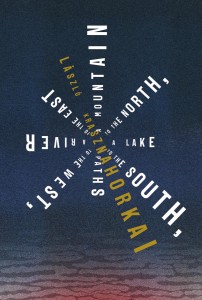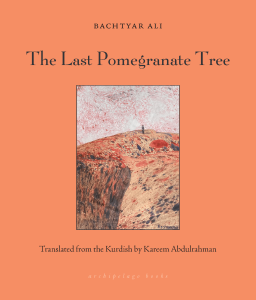2023 is already setting up to be one of the most wide-ranging and bounteous years for literary purveyors of the world, with an abundance of exciting works slated for publication. This month, we’re presenting three texts that enrapture the imaginative prospects of a world in translation: László Krasznahorkai subverts every expectation for the travelogue, Bachtyar Ali braids storytelling and truth-seeking, and Maria Adolfsson reasserts feminist presence in the male-dominated mystery genre.

A Mountain to the North, A Lake to The South, Paths to the West, A River to the East by László Krasznahorkai, translated from the Hungarian by Ottilie Mulzet, New Directions/Serpent’s Tail, 2023
Review by Matthew Redman, Digital Editor
László Krasznahorkai is among Hungary’s most feted writers in the Anglophone world. His works, characterised by inordinately long, slow sentences which chart the depths of obsession and madness, have earned him a cult of devoted readers and international acclaim, while his translators—Georges Szirtes and Ottilie Mulzet—are lauded writers in their own right. However, his most recent novel to be translated into English, A Mountain to the North, A Lake to The South, Paths to the West, A River to the East, is an intriguing departure from the works that have made his name. The vast sentences he is known for are intact, but they are used in service of a radically different tonal palette. Where his other novels use length to induce futility and despair, A Mountain to the North explores the beatific, languorous, and even beautiful possibilities of extreme syntax.
Set in Japan, the novel takes the form of a travelogue—albeit with the sheer mass of textual detail slowing the journey to an ooze. Strip this away and you find comparatively simple structural bones: a train deposits us at a deserted platform somewhere in Kyoto, we leave the station and wander half-lost through empty streets until we arrive at our destination, a Buddhist monastery in which we remain for most of the novel, touring the grounds and slowly penetrating the interiors. It is a balmy late afternoon, there are beautiful gardens all around, the monastery is silent and exquisite. This part of Kyoto is almost entirely bereft of inhabitants, but the emptiness is one of the rare details that Krasznahorkai chooses not to linger on. In fact, the absence is fortuitous, because the novel is uninterested in people; what consumes the author instead is the immutable, near indescribable beauty of things wrought in accordance with Japanese tradition. With the streets and monastery empty, the prose is freely devoted to the description of his sublime surroundings. Plants in their carefully tended gardens; the shrine’s architecture—their calculations and materials, the minutiae of their construction; the nigh-divinely sagacious prescriptions according to which every detail within the monastery was planned, planted, and built; the commitment at every turn to the tireless refinement of perfection; and above all the feel of all of this beauty—the texture and the grain, and the effect on the soul.
Each chapter houses a single enormous sentence that describes and extols a single beautiful object (a gate, a shrine, a statue) or craft (carpentry, gardening), and ends only when Krasznahorkai deems the subject exhausted. As demanding and unconventional as this novel is, it is not difficult in the way that experimental fiction is often thought to be. For all its density, there is a deceptive simplicity, even a solicitousness to Krasznahorkai’s prose. His sentences are slow enumerations in service of a simple message that never changes: the monastery and everything within it are perfect, and it could only ever have been so, for it is all the product of patient, genius craftsmen adhering immaculately to faultless prescriptions. The long succession of accounts of perfect things has an incantatory quality, the meticulousness neither torturous nor bewildering, but rather intended to soothe. Krasznahorkai wants to leave you tranquil:
[…] it was something like a labyrinth, of course, but at the same time the chaos causing the oscillation of the layout of these streets wasn’t frightening and even less so futile, but playful, and just as there were finely wrought fences, the grated rolling gates protected by their small eaves, above, leaning out from both sides here and there, were the fresh green of bamboo or the ethereal, silver foliage of a Himalayan pine with its firework-like leaves unfolding; they bent closely over the passerby as if in a mirror, as if they were protecting him, guarding him and receiving him as a guest within these tightly closed fences and gates, these bamboo branches and the Himalayan pine foliage; namely, they quickly gave notice to the one arriving that he had been placed in safety […]
Krasznahorkai and Mulzet have both paid careful attention to prosody, so that we may read this novel in accordance with the author’s intentions. Although full stops are absent, the sentences bristle with punctuation: commas and semi-colons keep the flow measured, meditative, additive, rolling calmly on, on, on. In a word, take it slow. And it works: a calm descends over you, and the mind quickly adjusts and resigns itself to the inexorable swell of information.
Tranquillity curdling into boredom is the chief danger here, and one of the impressive achievements of A Mountain to the North is how well it maintains its reverie—how dull it isn’t. Credit here is due to author and translator in equal measure; sentences of this length and delicateness pose an extreme technical challenge to the translator, one that is made harder still by certain grammatical disparities between Hungarian and English—the largest of which being the agglutinative nature of Hungarian, which can accommodate long sentences more easily than English can. Nevertheless, Ottilie Mulzet succeeds, and her sentences mesmerise. There are occasional and possibly inescapable moments of ponderousness—a stubby clause, a qualification too many—but Mulzet renders the formidable syntax with great skill and care. Very rarely do you yearn for one of these sentences to end.
Krasznahorkai, for his part, ventures increasingly beyond his descriptive mode as the novel progresses. A plot begins to materialise in parallel with the assiduous tour of the monastery, in the form of a mysterious, anachronistic Japanese nobleman, referred to only as the “grandson of prince Genji.” He appears belatedly, alighting from the train after we do, and repeats our journey through Kyoto. An inconstant presence at first, crowded out of the narrative by descriptions, the focus of the novel gradually shifts onto him. At the same time, small but disturbing events punctuate both his slow progress and the mesmeric enumerations. Down in the city, a mutilated dog crawls under a gingko tree to die; the weather changes, and all that is alive in Kyoto seems to freeze for one long moment; the novel’s gaze lingers on the expression of an achingly disconsolate buddha in the monastery’s Golden Hall, whereupon, in one of the novel’s few sudden shifts, the novel’s ugly misanthropy bares itself openly.
From here on, the drip of ominousnesses begins to quicken, and the novel takes a turn towards more familiar ‘Krasznahorkaian’ territory. The narrative shifts more firmly to the prince, who we learn is on a quixotic search for an impossibly beautiful garden. At the same time, the ugly trappings of modernity make ever more conspicuous intrusions. Back at the train station, we begin to notice vending machines and computer cables, while in another chapter, a chaos of television aerials on the city’s rooftops obscures the view of the titular “lake to the south”. Decay and vandalism in the monastery itself become impossible to ignore. The chapters become even longer and increasingly bewildering, culminating in the longest, most disconcerting, most Krasznahorkaian chapter of the novel, in which a book of theoretical mathematics lying incongruously in the monastery’s inner sanctum is described at excruciating length.
On the other side of this is where the novel, for the first time, becomes truly beautiful; the descriptions modulate, by some subtle and amazing feat of composition, from incantatory to joyous and then to elegiac. You emerge from the end of the book to find that a journey has transpired. You haven’t moved, but Krasznahorkai’s bottomless sentences have distorted time and space. His experiment succeeds, and strange emotional admixtures are the result: tranquillity, sadness, awe, exhilaration, numbness.

The Last Pomegranate Tree by Bachtyar Ali, translated from the Kurdish by Kareem Abdulrahman, Archipelago Books, 2023
Review by Andrea Blatz, Blog Copy Editor
Bachtyar Ali’s most recent novel posits a set of questions, ranging from identity and memory to fatherhood and community, and through the kaleidoscope of these vast ideas, the prose reigns in a medley of realities and phantasms: the fantastic sisters in white, the very real traumas resulting from Saddam Hussein’s reign, the Iraqi–Kurdish conflict, and so on. In Kareem Abdulrahman’s English translation (his second of Ali’s works, the first also being the first Kurdish novel to appear in English), all these facets are brought to life.
The book opens with two stories being told nightly, in the way of One Thousand and One Nights. Switching between the narrator, Muzafar-i Subhdam, who speaks of his experiences in captivity (the first lasting twenty-one years in the desert, the second at the hands of a childhood friend, Yaqub-i Snawbar, in a green mansion), and Muhammad-i Dilshusha, or Muhammad the Glass-Hearted, the stories eventually merge into one after Muzafar describes escaping his second prison to search for more information about his son, Saryas-i Subhdam, who was born a few days before his first imprisonment began.
After spending his years in prison trying to forget—“all my memories turned to sand”—Muzafar is released from his desert confinement and immediately tries to locate his son. It is this persistent search for truth that lies at the heart of The Last Pomegranate Tree. As he explains, “I have a journey, and I need to make it. I have a mission, and I need to accomplish it. That’s just how things are. There’s some reason I haven’t died in the past twenty-one years.”
For some time, Muzafar’s efforts are thwarted by Yaqub-i Snawbar, who, despite having released him from his first prison in the desert, detains Muzafar for a second time, and simply tells him that his son died. Yaqub believes that keeping Muzafar in the mansion will protect him from the pain of not being able to find the answers he is searching for. Moreover, Yaqub wants Muzafar to live and reflect with him, since Yaqub “felt that he had grasped all the superficial things in life but failed to penetrate its essence,” and believes that Muzafar, having spent a time of deprivation in the desert, can help him achieve wisdom. Muzafar, determined to leave and learn the truth of his son’s death, catches a lucky break when a stranger shows up and helps him escape.
However, we soon learn that the truth isn’t as clear-cut as we might have imagined, and the rest of the book unravels the story of Muzafar’s son. I use “story” here, instead of “truth,” because his son’s fate is the one truth that can never be revealed. Three baby boys had been given the name Saryas-i Subhdam (a rare name, we are told) and placed in different families in Iraq. All three experienced the horrors of war with different outcomes: one died, one became a peshmerga fighter and ended up in prison, and the third was terribly burned in a bombing. In the end, Muzafar learns to reject the need to truly know which boy is his son. Instead, he accepts all three. The truth, then, is not as important as he had believed; what becomes more significant is the broader notion of fatherhood and caring for those around you.
Additionally, the fantastic elements of the book also subvert the truth. The book, published originally in 2002, takes place in Iraq with the backdrop of constant conflict—families torn apart, individuals suffering grave injuries, and the endurance of emotional trauma. Certain characters and places, however, seem to exist outside that reality. Muhammad the Glass-Hearted, for example, is introduced as a fantastical character, also seeking the truth of Saryas’s past. After being swept in a flood to arrive at the doorstep of the sisters in white, he falls in love with one of them, and dies when this love in unreciprocated. The sisters, too, are fantastic subversions of the truth, depicted as always wearing white dresses, never covering their heads, and singing through the streets. Their presence in the text is a sharp contrast to the reality of the horrors, as they seem to be completely unaware of the destruction around them.
The titular last pomegranate tree, too, surpasses reality; it is said to have supernatural healing powers, having “grown on the border of two kingdoms, the realm of reality and the realm of dreams.” Nadim-i Shazada, a friend of one of the Saryas, explains that his father planted the tree for him before his death, and that “he must sleep under [the pomegranate tree] in order to regain his sight.” Nadim knows exactly how to get to the tree: one thousand steps this direction, through a muddy path, up a mountain, and the tree will be at the summit. Despite the promises of his father, Nadim wakes up still blind. However, he had spoken to his father in his dream, whereupon the older man explained:
Day after day, a light will grow inside you, until the day comes when you will be able to tell rotting and sweet fruit apart just by smell, identify the secret desires of others by the sound of their whispers, and intuitively know how to navigate every road. [. . .] One day you will be able to see, but before that, you must understand the meaning of seeing. Nadim, those who killed me had eyes, but they couldn’t see me.
In this, Ali shows his readers that while truth at first seems a monolith, a different perspective can reveal a new aspect, a new verity, equally as valid as the first. It is as Muzafar wonders: “After all, what is life but a great detour from what we think of as ‘normal’ until we look at things from a new perspective?”

Cruel Tides by Maria Adolfsson, translated from Swedish by Agnes Broome, Zaffre, 2022
Review by Irmak Ertuna Howison, Educational Arm Assistant
Crime genre, due to its subject matter, inevitably centralizes on the dark side of human nature, proliferating in scandalous secrets, immoral obsessions, and past mistakes. Even the “coziest” of mysteries—featuring Jessica Fletcher or Miss Marple—revolve around the conception of human nature as fatally flawed, though this bleakness was often soothed in the Golden Age of mysteries, wherein the reader reaches catharsis when the crime is solved, and the fragile order is restored. In contrast, however, the past few decades have witnessed the spread of a new element in crime fiction, in which the reader cannot satisfactorily reach catharsis—because the solution of the mystery throws us into deeper despair at the state of the world. The crimes are too dark to think about, the order is never really restored, and even the quick dissemination of TV shows, podcasts, and novels around the world increasingly accentuate the darker contours of the genre. Meanwhile, contemporary crime novels, despite following a well-established recipe of atmospheric settings, troubled detectives, and a crime engendered by a social ill (sexism, homophobia, etc.), bring little relief in their exposition.
Maria Adolfsson’s last installment in Doggerland Trilogy, Cruel Tides, is a successful iteration of this formula. Set in the fictional island states of Doggerland, the novels follow detective Karen Eiken Hornby, a captivating character complete with a tragic past and occasional bad decisions. Even though Doggerland is meant to neighbor the Scandinavian countries—which, in public imagination, represent progressive social values—Karen faces a revolting sexism as a woman officer of the law. After returning to her homeland from London, she observes that “the professional climate and the language used by her male colleagues and bosses had left her astonished at how much her fellow islanders had managed to avoid keeping up with the wider world.” Unsurprisingly, Karen has to work harder than her male colleagues to be taken seriously, while also exerting more emotional labor in solving her cases.
Similar to many successful contemporary crime novels, Karen’s experience as a woman is a significant part of the plot. Adolfsson problematizes the way women are treated in the world, exemplifying the context in scenes from both her character’s work and personal life. Her relationships outside of work also illustrate the multitude of ways women and queer people are marginalized, with instances of trauma caused by conversion therapy or lack of support for victims of sexual violence underscoring the despair. When rape victims hesitate to come forward, Karen notes that “this is far from the first time a husband, father, or brother of a rape victim has felt they have both reason and the right to feel personally violated. And not the first time that has made things twice as hard for the real victim.” Nevertheless, Karen doesn’t cave into despair. She has learned to survive in both her personal and professional lives. The physical injuries she accrues along way become the outward manifestations of her battles.
The real achievement of Cruel Tides (and the trilogy), however, lies in its exploration of another layer of woman’s experience, and one uncommon in most contemporary crime fiction: Karen is perimenopausal. She is not as fast as once she was; her hangovers last longer; and she has to suffer jokes about her exhausted demeanor. When she takes her office mandated physical exam, she feels hopeless: “She’d been prepared to be admonished for her lack of stamina and she had agreed to subject herself to the torture of having her breasts flattened in that infernal machine. Hurt like hell, it did, but she’s been stoic about it. But menopause? Oestrogen? It’s too much.” But Adolfsson doesn’t paint a gloomy picture of aging. Surrounded by her friends (and making new ones along the way), Karen enjoys life as much as a woman with her personal history can. By no means is she a sexless Miss Marple, and is instead a fully sensual person. It is not every day that we see a fictional woman detective deal with aging while also maintaining her sexual life. For this fact alone, the trilogy is a pleasure to read.
Although the reader can enjoy Cruel Tides as a standalone novel, the first two installments of the trilogy paint a vivid picture of Doggerland, offer crucial bits of Karen’s past, and introduce the recurrent characters. The novels of the trilogy are set as police procedurals, driving their strength from the relations between characters in the force’s hierarchy, as well as the processes of investigation itself. While the first two novels are whodunnits with twists and turns, the last one follows two separate investigations: a string of murders, and a missing pop star. The other exception is that in Cruel Tides, Adolfsson’s exploration of the social problems—in which the crimes are rooted—becomes more direct. The sexism in the office is no longer just the troubling background that Karen needs to overcome in order to do her job; it becomes part of the investigation.
While the police force traditionally represents the patriarchal order, strong women detectives like Karen reveal the underlying sexism, homophobia, and the doggedness of conservative family values that make life miserable for those who don’t fit in. Agnes Broome’s fluid translation makes Cruel Tides a page-turner that will please any reader who enjoy smart mysteries.
*****
Read more on the Asymptote blog:

